This ultimate guide to making tofu pudding (doubua / uncurdled soft tofu) explains how to use different coagulants and their results. The post includes recipes for using GLD, gypsum, gelatin, and agar agar and covers the methods and results using nigari and citrus. Look no further if you want to make the perfect tofu pudding using whatever ingredients you have on hand. {Vegan, Gluten-Free}
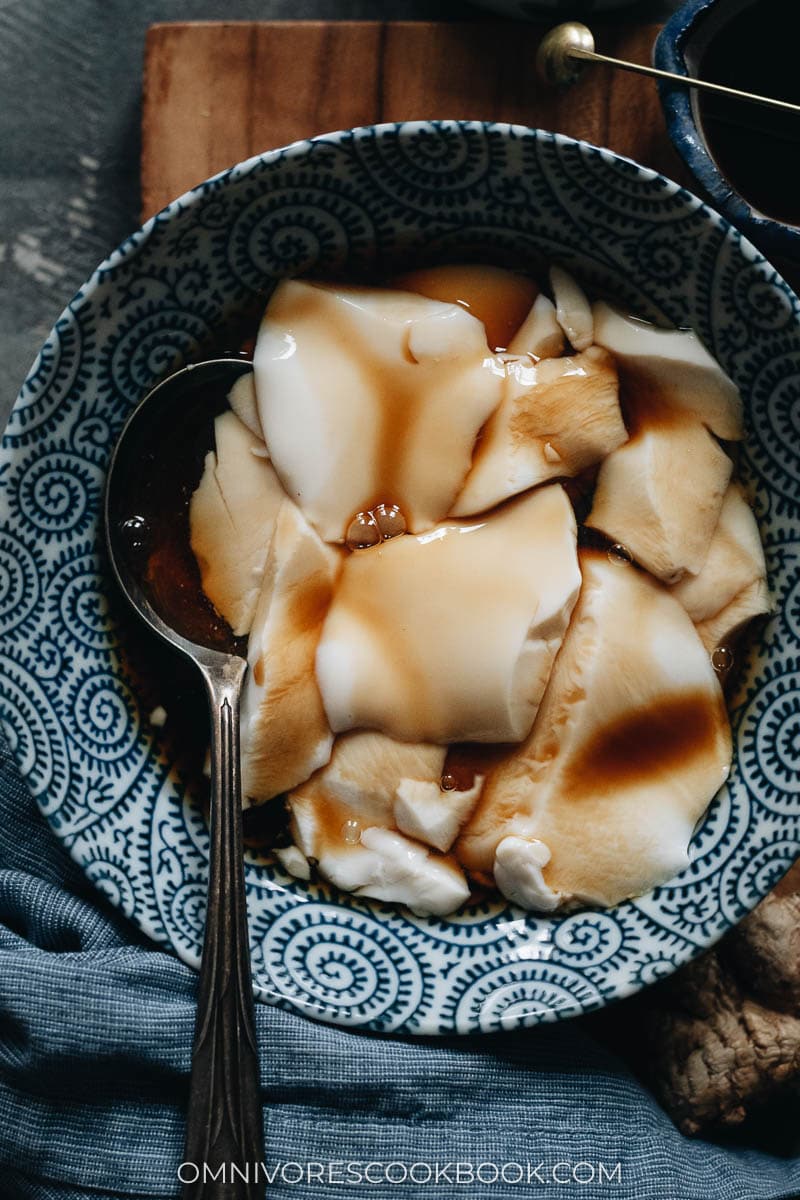
What is douhua / tofu pudding
Douhua, or tofu pudding, is a type of fresh, extra-soft, uncurdled tofu that is even softer than silken tofu. It is so soft that it’s often served with a ladle. In northern China, we call it Dou Fu Nao (directly translated, means “tofu brain”) and we serve it with a savory gravy. In southern China, people usually call it douhua and serve it with a gingery syrup. While traveling to central and western China, I’ve had the dish served with various savory sauces (usually soy sauce based) with fresh aromatics, pickles, and chili oil.
Douhua is made with soy milk and a coagulant to help it congeal. Different from making tofu, where you use a coagulant to make the soy milk curdle and then press it, making douhua is a simpler process. You simply need to dissolve the coagulant into the soy milk and let it set. That’s all.
Different coagulants for making tofu pudding
In order to find the best way to make douhua, my teammate Lilja and I decided to test out all the common coagulants and find out the best approach. We tested:
- GDL
- Gypsum
- Nigari
- Gelatin
- Agar Agar
- Citrus
The results
Long story short, we found out that the GDL produces the best and most consistent result. But it’s trickier when made in small batches because it requires a precise (to the tenth of a gram) scale to get a good result.
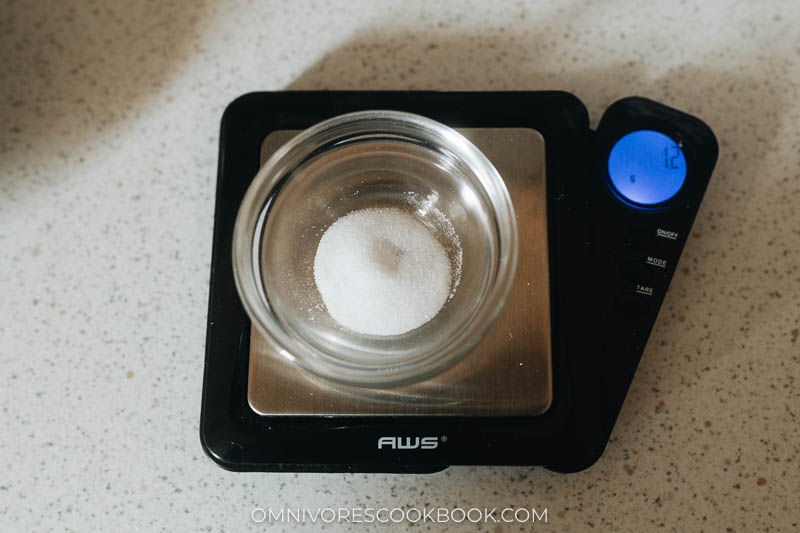
The gypsum method produces the second best result and it’s easier to make at home. Plus, since it’s also a coagulant used to make regular tofu, we picked it as another winner. Even if you accidentally curdle the soy milk while making douhua, you can still press it into tofu. So there is no waste.
The nigari and citrus methods didn’t work out. Both led to curdled tofu after many tests so we had to forego these methods.
Gelatin and Agar both make OK results, but they produce a bouncy jelly-like texture that I find a bit weird. (PS. My husband Thomas loved it (lol), though, I think if you didn’t grow up eating this dish you might like the result)
You can jump to the recipe below if you want to use the gypsum method. I also included all the methods in the blog post below, in case you want to use a different coagulant.
Homemade soy milk VS. store-bought
They both work!
Homemade soy milk has a thicker texture so it requires less coagulant and the result tastes slightly better. However, we understand that you might not want to make soy milk from scratch every time you make douhua. We tested the store-bought soy milk as well and the result turned out totally OK.
The only thing to note is that you need to make sure the store-bought soy milk contains only soybeans and water. I’ve only seen this kind at Chinese markets, other Asian markets, and Trader Joe’s (the Trader Joe’s brand soy milk). The additives in packaged soy milk might affect the coagulation process and won’t produce a great result.
I have included the amount of adjusted coagulant measurements below, using store-bought soy milk.
The only thing we didn’t test is homemade soy milk made with a soy milk machine. Because I had to get rid of my soymilk maker when moving to New York due to my limited space. Based on my previous experience, the soy milk made with the machine is slightly thinner than the version without, so you should use the measurements for the store-bought soy milk.
The methods of making douhua
There are two ways of making douhua – the steaming method and the pouring method. For the cooking part, we tested both steaming and pouring.
The steaming method (recommended)
To use the steaming method, you will have to use a soy milk that is cold or at room temperature. The cooking requires a heat-proof bowl and a steamer. You will need to:
- Dissolve the coagulant into a small amount of soy milk
- Pour in the rest of the soy milk and stir again
- Cover the bowl with plastic wrap and steam
We highly recommend the steaming method because it is reliable and always produces consistent results.
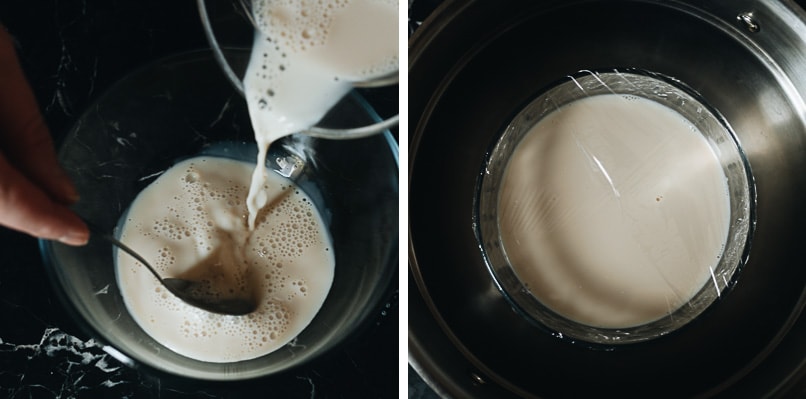
The pouring method
The pouring method is quite popular because it’s convenient when you’re making a fresh batch of soy milk and using the hot milk to make douhua immediately. You will need to:
- Heat the soy milk until simmering (but not boiling hot)
- Combine the coagulant with a small amount of starch and water to dissolve
- Pour the hot soy milk over the mixture from about a foot (30 cm) above to allow the coagulant to mix in
- Let it sit, covered and undisturbed, for 20 to 30 minutes.
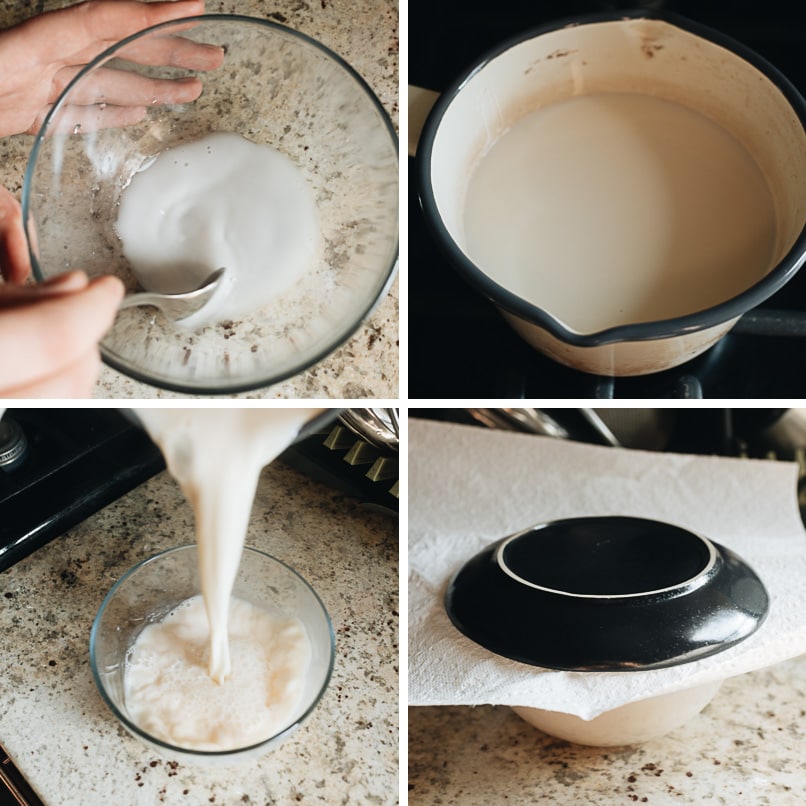
We do not recommend the pouring method because:
- It will cause a lot of bubbles on the surface so the result will look less perfect (you cannot skim the bubbles because doing so affects the coagulation process)
- Once poured, you have to keep the bowl absolutely still. If you move it or accidentally jiggle it, the soy milk might curdle.
- The pouring method does not work if using gypsum, because 50% of the time the soy milk will curdle.
However, if you prefer to use GDL as the coagulant, it’s totally OK to use the pouring method and the result will be very consistent.
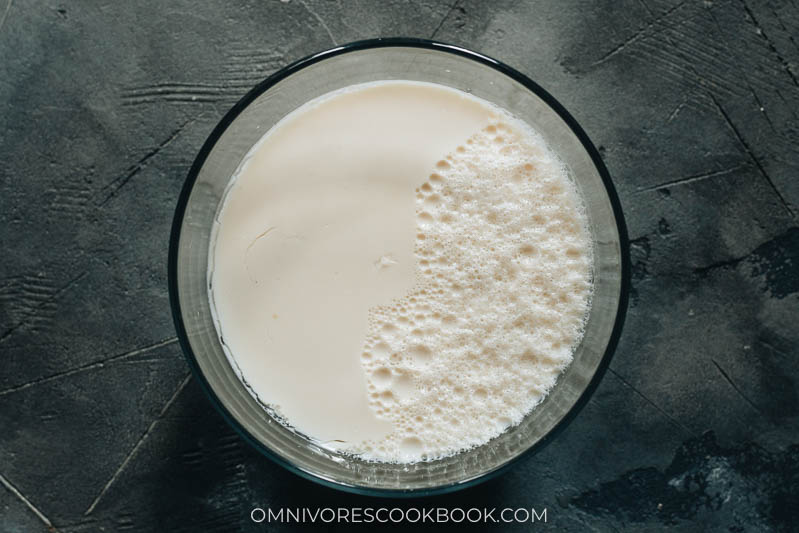
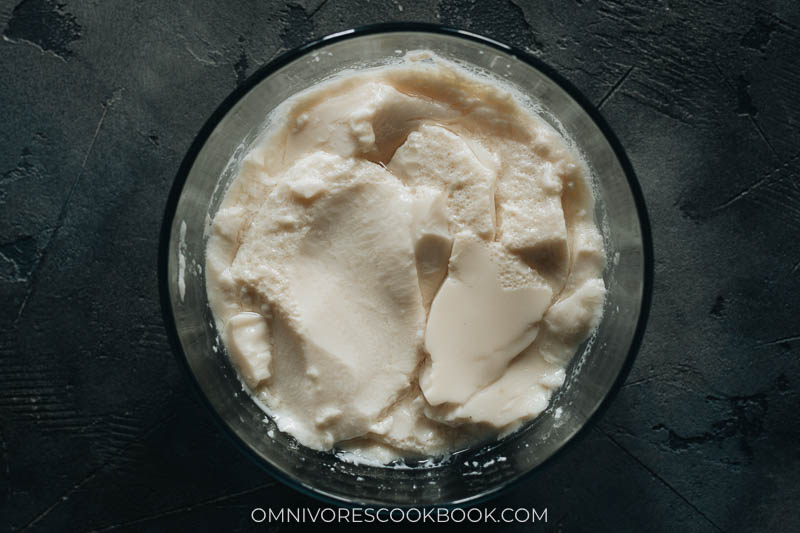
The recipes for making Douhua using different coagulants
I’m including all the recipes to make douhua using different coagulants. You will also find the gypsum method at the end of the post in the recipe card with a gingery syrup recipe. I included only that one in the recipe card because it’s my favorite.
Making douhua using gypsum (recommended)
Gypsum is a soft sulfate mineral which is a main ingredient in plaster and drywall. It’s commonly used in China to make tofu and douhua the traditional way.
We love the gypsum method because it produces a very smooth texture and the result is quite consistent even if you do not use a scale. The downside is, you will need to use the steaming method for gypsum since the pouring method curdles a lot and the texture is bad even when the soy milk doesn’t curdle.
You can usually find it at Asian markets or on Amazon.
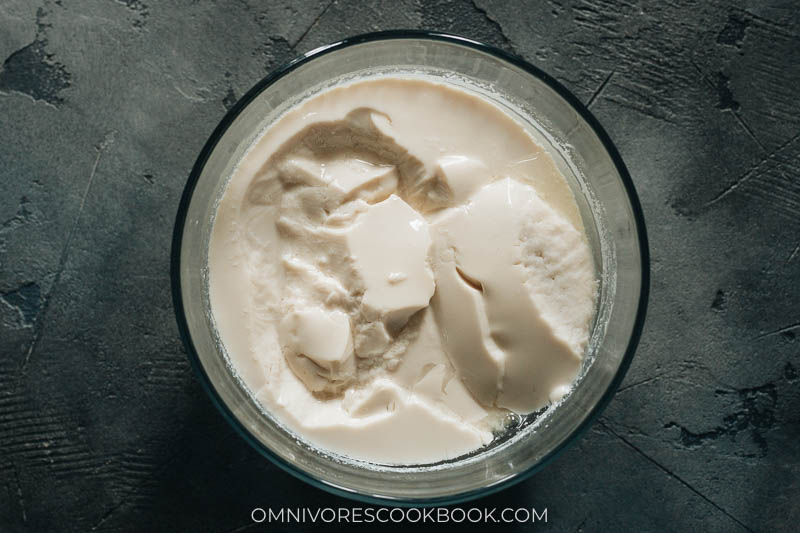
MAKING DOUHUA USING GYPSUM
INGREDIENTS
- 400 ml (1 2/3 cup) homemade soy milk (or store-bought soy milk), cold or room temperature (*Footnote 1)
- 2 g (1/2 teaspoon) gypsum (*Footnote 2)
- (Optional) Pinch of salt and/or sugar (*Footnote 3)
INSTRUCTIONS
- Prepare a heatproof bowl or container that can hold at least 2 cups of water and will fit into your steamer. Add the gypsum, salt/sugar if using, and a small amount of soy milk into the bowl. Mix until fully dissolved. Then slowly pour in the rest of the soy milk and stir constantly to mix in the gypsum. Cover with plastic wrap.
- Add water to your steamer and bring it to a full boil. Place the bowl with the soy milk mixture into the steamer, cover the steamer, and steam for 10 minutes over high heat.
- Once done, remove the steamer from the stove. Uncover carefully to let the steam out, and poke a few holes with a fork on the plastic to release the condensation while the tofu cools.
- Once the steam is mostly released, remove the plastic wrap and serve the douhua warm or cold.
FOOTNOTES
1. If using store-bought milk, it should contain only soy milk and water.
2. Since store-bought soy milk is thinner, you will need to increase the amount of gypsum to 3/4 teaspoon (3.5 g).
3. The added salt/sugar will mask the mild taste of the gypsum if you eat the tofu curd plain. But since you will usually be serving it with a sweet or savory sauce, or use the curd in other recipes like a soup, I don’t see the need to add the sugar/salt, so I usually don’t.
Making douhua using GDL (recommended)
GLD, or Glucono Delta Lactone, is a food additive as an acidifier (also commonly used in making feta cheese).
Compared to the traditional gypsum, GDL is popular these days, especially in restaurants. When making douhua, it produces a smoother, more silky texture, and the result is always consistent. As a general rule:
(Grams of soymilk) x .0025 = Grams of GDL
As long as you follow the rule, you will always get the same smooth and soft texture.
The only downside is, it’s hard to measure GDL if you’re making douhua in small batches. For example, you will need 1 gram GDL for 400 ml soy milk that yields two servings. To measure 1 gram, you will need a special scale that is precise to 0.1 gram.
During the testing, we tried using the spoon measurement. Unfortunately, a 1/4 teaspoon GDL yields anywhere from 0.7 grams to 1.2 grams, producing a result that is either too soft or too firm.
Our conclusion is that, if you really love douhua and plan to use the pouring method, you should get a scale and use the GDL method.
You probably need to shop for GDL on Amazon because it’s a special ingredient and even most Asian markets do not carry it.
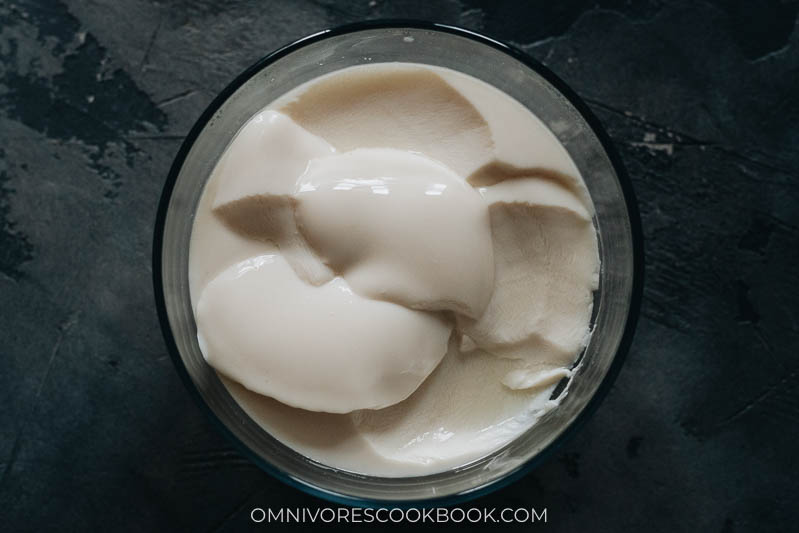

MAKING DOUHUA USING GDL
INGREDIENTS
Steaming method
- 400 ml (1 2/3 cup) homemade soy milk (or store-bought soy milk), room temperature
- 1 g GDL (1/4 t) (*Footnote 1)
- (Optional) A pinch of salt and/or sugar (*Footnote 2)
Pouring method
- 1 g cornstarch (1/4 t) (*Footnote 1)
- 1 tablespoon water
INSTRUCTIONS
Steaming method
- Prepare a heatproof bowl or container that can hold at least 2 cups of water and will fit into your steamer. Add a small amount of the GDL, soy milk, salt/sugar if using, and mix until fully dissolved. Then slowly pour in the rest of the soy milk and stir constantly to mix in the GDL. Cover with plastic wrap.
- Add water to your steamer and bring it to a full boil. Place the bowl with the soy milk mixture into the steamer, cover the steamer, and steam for 9 minutes over high heat.
- Once done, remove the steamer from the stove. Uncover carefully to let the steam out, and poke a few holes with a fork on the plastic to release the condensation while the tofu cools.
- Once the steam is mostly released, remove the plastic wrap and serve the douhua warm or cold.
Pouring method
- Heat the soymilk in a small pot until simmering but not boiling.
- While heating the soy milk, combine the GDL, cornstarch and water in a small bowl. Stir to dissolve completely. Right before pouring the soy milk, you should stir again because the GDL will separate if the mixture sits for too long.
- Pour the hot soymilk over the mixture from a foot (30 cm) above, which will allow the GDL to mix in thoroughly. Do not touch the mixture or move the bowl once poured, so the douhua can properly set.
- Cover with a few layers of kitchen paper towels and secure it with a lid or a large plate, so the paper will absorb any condensation and won’t dip into the soymilk. Let sit undisturbed for 20 to 30 minutes.
FOOTNOTE
1- I highly recommend using a precise scale for GDL because the teaspoon measurement is not accurate at all. If using store bought soy milk, use 1.5 g (a heaping 1/4 tsp or 3/8 tsp) GDL.
2- The douhua will have a bit acidic aftertaste without using any sugar or salt. But if you serve it with a sauce, the aftertaste is not noticeable.
Making douhua using Gelatin
Gelatin is a translucent flavorless powder made from collagen taken from animal parts. So you should avoid this method if you’re vegetarian or vegan.
Although it looks soft and smooth on the picture, I personally do not like this method because it produces a Jello-like texture that is slightly bouncy and sticky. It also only produces cold douhua due to the cooking method.
But gelatin is an ingredient that is easy to find and you can usually get it at a regular grocery store.
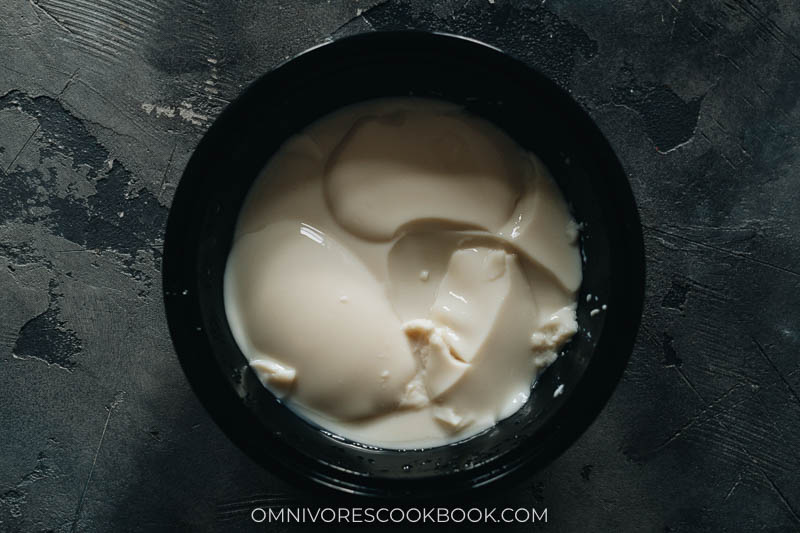
MAKING DOUHUA USING GELATIN
INGREDIENTS
- 325 ml (1 1/3 cup + 1 teaspoon) homemade soy milk (or store-bought soy milk), cold or room temperature
- 1 teaspoon gelatin
INSTRUCTIONS
- Add 2 tablespoons of the soymilk to a heatproof bowl and sprinkle over the gelatin. Let sit for 5 minutes.
- Add the remaining soymilk to a small pot and bring to a boil. Pour over the hydrated gelatin mixture. Mix with a spoon until the gelatin is completely dissolved.
- Cover with a few layers of kitchen paper towels and secure it with a lid or a large plate. Transfer the bowl to the refrigerator and let rest for at least 4 hours.
- Serve cold or at room temperature.
Making douhua using Agar Agar
Agar Agar (or agar) is a jelly-like substance made from red algae, a type of seaweed. It’s a common ingredient in Japanese cuisine and a popular one to replace gelatin to make vegan desserts.
I have included this method because agar agar is relatively easy to find, especially in Asian markets and organic grocery stores. You can also find it on Amazon.
But similar to gelatin, it creates a texture that is jelly-like with a slightly stiff mouthfeel. The method also only produces cold/room temperature douhua. I do not recommend this method if you’re looking for a very authentic douhua texture.
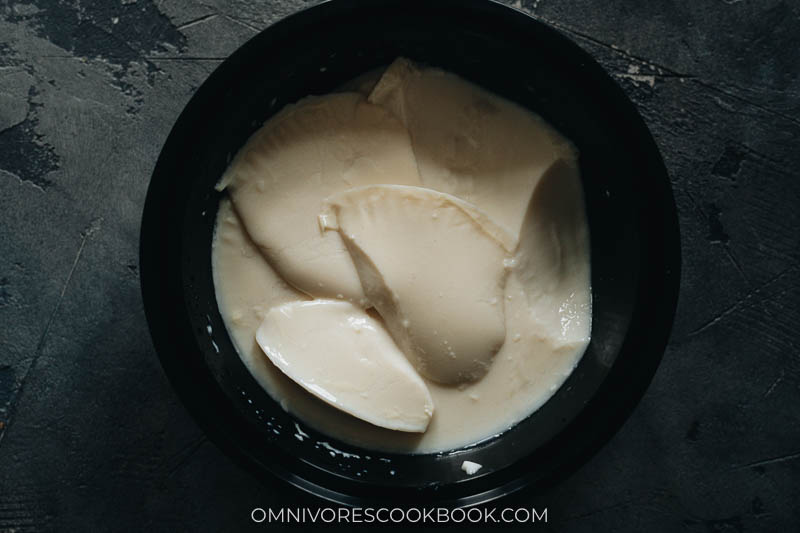
MAKING DOUHUA USING AGAR AGAR
INGREDIENTS
- 325 ml (1 1/3 cup + 1 teaspoon) homemade soy milk (or store-bought soy milk), cold or room temperature
- 1/2 teaspoon agar agar
INSTRUCTIONS
- Combine the soy milk and agar agar in a small pot and stir to incorporate. Heat over medium-high heat, stirring constantly, until bringing to a light boil. Turn to medium-low heat to reduce it to a low simmer, then cook for another 5 minutes or until the agar agar is fully dissolved.
- Pour the mixture into a heat proof bowl or container. Cover with a few layers of paper towels and secure it with a lid or a large plate. Transfer the bowl to the refrigerator and let it rest for at least 1 hour.
- Serve cold or at room temperature.
How to serve douhua
Douhua can be served hot or cold. In the recipe below, I’ve included the popular ginger syrup to serve the dish as a dessert.
Growing up in Beijing, I’ve always eaten savory douhua. The sauce is made with minced pork and other dried ingredients in a brown gravy. It’s usually served as a breakfast along with Chinese donuts (You Tiao). I will share the recipe with you soon!
Keys to making the perfect douhua
Choose either gypsum or GDL as a coagulant if you plan to make douhua more than once. It’s definitely worth the trouble to order it online.
No matter which coagulant you’re working with, the measurement will vary slightly depending on the soy milk you use. My measurements are based on my homemade soy milk (without a soy milk machine), using 8 oz (226) dried soy beans to yield about 6 cups (up to 6 1/2 cups) of soy milk. If you’re using a different soy milk formula, the measurement of the coagulant might change slightly because your soy milk might have a different thickness. But if you keep making douhua with one type of soy milk, you can slightly tweak the coagulant amount to achieve the perfect texture.
I also highly recommend getting a kitchen scale no matter which method you use.
In general, the gypsum method is quite forgiving and you can get away without a scale. But if you want the perfect result every time, you should use a precise scale with GDL.

Afterthoughts
Making douhua might sound intimidating at first. But once you understand the method and get the proper measurements, it’s actually very easy to make at home. No matter whether you’re trying to recreate your childhood memories or searching for a new way to enjoy tofu, this is a perfect recipe for you.
Want to learn more about Chinese Cooking? Sign up for my newsletter to receive the 5-Day Chinese Cooking Crash Course and recipe update!
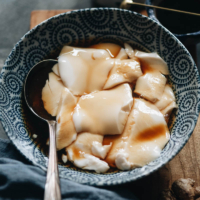
The Ultimate Guide to Making Douhua (Tofu Pudding)
Ingredients
Douhua (with gypsum)
- 400 ml (1 2/3 cups) homemade soy milk (or store-bought soy milk), cold or room temperature (*Footnote 1)
- 2 g (1/2 teaspoon) gypsum (*Footnote 2)
- Optional Pinch of salt and/or sugar (*Footnote 3)
Ginger Syrup
- 1/2 cup brown sugar
- 1/2 cup water
- 1/2 ” (1 cm) ginger , sliced
Instructions
Douhua
- Prepare a heatproof bowl or container that can hold at least 2 cups of water and will fit into your steamer. Add the gypsum, salt/sugar if using, and a small amount of soy milk to the bowl. Mix until fully dissolved. Then slowly pour in the rest of the soy milk and stir constantly to mix in the gypsum. Cover with plastic wrap.
- Add water to your steamer and bring it to a full boil. Add the bowl with the soy milk mixture, cover the steamer, and steam for 10 minutes over high heat.
- Once done, remove the steamer from the stove. Uncover carefully to let the steam out, and poke a few holes in the plastic with a fork to release condensation while the tofu cools.
- Once the steam is mostly released, remove the plastic wrap and serve the douhua warm or cold. (Footnote 4)
Syrup
- Add the brown sugar, water and ginger to a small pot. Heat over medium heat until bringing to a boil. Turn to medium-low heat to reduce to a simmer, then cook for another 5 minutes.
- Pour over tofu pudding and enjoy!
Notes
- If using store-bought milk, it should only contain soy milk and water.
- Since store-bought soy milk is thinner, you will need to increase the amount of gypsum to 3/4 teaspoon (3.5 g).
- The added salt/sugar masks the mild taste of gypsum if you eat the tofu curd plain. But since you will usually be serving it with a sweet or savory sauce, or use the curd in other recipes like a soup, I don’t see the need to add the sugar/salt so I usually don’t.
- If the tofu pudding gets curdled by accident, it can be pressed into a block of extra-soft silken tofu.
- This recipe produces extra syrup. You can store it in an airtight container in the fridge for up to 1 month.
Nutrition
Other recipes you might be interested in
- Easy Hand-Pulled Noodles
- How to Make Chinese Dumplings from Scratch
- How to Make Steamed Bao Buns (Gua Bao Buns)
- Gua Bao (Taiwanese Pork Belly Buns, 割包)
- Wonton Soup
Lilja Walter is a part of the Omnivore’s Cookbook team and worked closely with Maggie to develop and test this recipe.













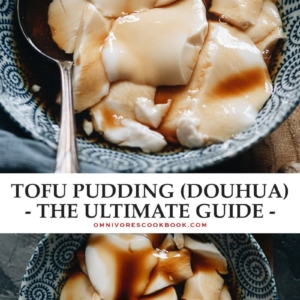
This is so exciting! I had a dish like this many years ago that had a lovely, fanciful name (something like moon rock garden) that I could never find info for online. Just pictures of actual gardens. It was a vegan restaurant, so I knew it wasn’t egg, but I wasn’t sure how it was made. This has been bugging me for just over a decade because I assumed it was steamed so I looked in all the wrong places.
These days, I do all my steaming in my instant pot. Having made the dish many times, do you think it could work in a pressure cooker?
*wasn’t steamed. Typo, sorry.
Hi Alex, I’m sure you can use your Instant Pot for the steaming but you need to set it to “steam” (I believe it’s low pressure if you use that function). When you ate the dish at the vegan restaurant, what type of sauce did they serve it with? I included the sweet one, which is more mainstream. I’ll also share a savory version soon 🙂
It wasn’t sweet and there were vegetables on top. I think they were meant to be the ‘garden’ part of the name? Overall, it didn’t feel super complicated in terms of flavor but was deeply satisfying.
Hi Alex, I just shared the savory version of tofu pudding: https://omnivorescookbook.com/dou-fu-nao/
It might not be completely the same like the version you had, since each region has their own formula to make the sauce and toppings. But I think you might enjoy this one 🙂
I’m grateful for your in deep guide!
I used to make Douhua with gypsum, but after a couple of years I tried to remake my successful recipe the soy just curdled and could not gelatinize.
Could you confirm if Gypsum do really get spoiled after some time?
Thanks
Glad to hear you find this post helpfu!
I’m not sure if Gypsum actually get “spoiled” since I never kept a bag for too many years. But I do think that it gets dated over time if you don’t store it properly. If you keep them in a not perfectly sealed bags, it will be absorb moist from the air and become less fresh and effective.
Impressive! Thank you for breaking down the formula for using gypsum amounts vs. gelatin. I will make this. Thanks for sharing!
I have never bought or use gypsum before. Where do I buy gypsum? I live in a small town so if I cannot find gypsum what can I substitute it with & the amount of the substitutes?
You can totally just use the orange juice. The tea is only an option if you like the flavor but I personally always use the orange juice for a fruity flavor.
Hi Maggie, where did you buy the GDL? Thank you!
I have been trying to make this for years. Every recipe I’ve seen says to use the crashing method but it has NEVER turned out smooth! Always bubbly. I gave up but then saw your recipe to steam and OMG, game changer!! So much faster and so smooth! Thank you!
I tried to make this previously using the pouring method, and it didn’t come out that smooth. I just tried this over the weekend using the steaming method with gypsum. It was amazing! Thank you so much for the recipe. It saves me time experimenting.
I’m inspired to try this! When using the steaming method, what is the purpose of the plastic wrap? Is it to keep the condensation from dropping into the pudding? I don’t usually use plastic wrap when cooking so was trying to determine if there’s an alternative option.
Yes the plastic wrap keeps the condensation from dropping into the bowl.
You can use a towel between your steaming pot and the lid to help with the situation.
You can also use a bamboo steamer (or bamboo steamer lid) and that will reduce the condensation by a lot.
Can I just place a lid on the dish before placing the dish into the steamer?
Yes you definitely can.
For the steaming method using GDL, do you have to work quickly? Will movement of the bowl into the steamer make it curdle?
I don’t think so. It should be activated with heat so any movement prior steaming shouldn’t be a problem.
I had a go with the gypsum/steaming method and it worked quite well – I just have a couple of questions. How do you know when it’s ready, can you steam it for too long? Does it ‘set’ further when it’s cooled?
Most importantly, mine had a layer of water which I don’t see in your pictures – how have I ended up with this? Thanks 🙂
The douhua is ready when it’s fully set and congealed. I actually don’t know if you can cook it for too long because I’ve never tried that.
The top layer of water is normal – it’s like making tofu, when the curd is set, you will always have some excess water at the end. When you break the curd apart, you will see even more water seeping out. What I did is to use a shallow spoon to remove as much water as I can, so it won’t dilute the sauce I use later on. But it’s quite normal to always have a bit water in your bowl (when I order it from street vendor back in China, the bowl always has some excess water as well, after the curd is being handled).
Hi Maggie.,
How do you make douhua smooth?
I tried the steaming and pouring method with gdl and it still turned out astringent and gritty pudding structure. The surface looks smooth though
If the texture is watery, I wonder if you didn’t use enough GDL. Although it’s weird that the texture is gritty and stringent, which sounds like too much GDL to me. The other thing is, the soy milk texture matters a lot too. I used my own homemade recipe for soy milk, which yields a good dou hua. If you use storebought milk, it might not work because the milk is more watery. If you used homemade milk but reduced / cooked it to a different thickness, the result of douhua varies as well. That’s the tricky part of using GDL in small batches, which requires very precise measurement.
Thank you so much for this guide!
Sadly I’m struggling with the GDL steaming method – using cooled homemade soy milk, in a bamboo steamer. It doesn’t set to a pudding texture, but goes straight from liquid to forming a foamy/stringy skin on top, to a flat spongy “cake” sitting in water. Still tasty after pressing it and using for tofu scramble, but I want silken tofu…
Before I ruin another batch, what do you think went wrong? Should I try more or less coagulant? Pre warming the milk?
For the GDL method, you really need to measure the grams using a 0.01 g precise scale (like this one https://amzn.to/3IRhFUf) for a reliable result. If you reply on the teaspoon, the amount can be quite off. Unfortunately that’s the issue with this method when you make small batches, which requires very precise measurement…
If you double or triple the serving, does the steaming time increase?
It is more about the shape of the bowl you use. For example, if using a super deep bowl, you will need to increase the steaming time. And if using a shallow bowl, the steam time doesn’t change even if you increase the serving. If you’re not sure, double the cooking time and check it in between. And cook a bit longer if needed.
This recipe is great! However, when I steamed it using the gypsum method I found that there is always a grainy layer of gypsum at the bottom of the bowl. Am I doing something or is that normal and just have to throw it away?
I have no idea! But I suspect it’s the amount of gypsum that is not accurate. Depending on how you make the soy milk, every batch will have a slightly different consistency (how much water you reduce, how you strain the milk etc). Maybe next time try to slightly reduce the gypsum amount and see if it works better?
I got the grainy texture as well, I used store bought soy milk. I was wondering if I didn’t stir well enough.
Thank you for your detailed recipe! Do you have the recioe for soy machine made soy milk using gypsum please? I have tried 5 times, the mixture never set! Not sure if the concentration of beans is too thin? I am using 100g beans for 1.2L water.
Unfortunately I never successfully made douhua using the soy milk from a machine. I tried many types and it never sets no matter how much gypsum I used. I think maybe the soy milk is too thin. Also the progress of a soy milk machine works different. It cooks and blend the beans instead of blend first, then boil. Not sure if it affects the soy milk as well…
Dear Maggie ,
Finally, I found your recipe and I have done perfectly and consistent !
Thank you very much.
Vicky
Hi, why does th doufu fa give outs lots of water, and the texture becomes roug over time? Is there any way to top this happening if I don’t eat all a once and have some let ove?
Omg, my first time making this and I succeeded! I can’t believe how easy this was to make, it’s easier than buying it from a store. And I can make a fresh hot bowl whenever I want. It’s usually lukewarm by the time I buy it and bring it home. And then cold the day after. I’m so excited I can do this myself now. Thank you for sharing this recipe!
The only thing that scares me, is using the gypsum powder. Learning that it’s used for plaster and drywall turns me off a bit. I hope it’s ok to eat gypsum powder, cause I want to make more Toufu-fa.
Hi. I have been trying to make tofu flower for years, since I was a kid with my dad. It is always hit and miss with gypsum. I finally found some GDL at my local Asian store, made it tonight and it was perfect with the pour method. Just wanted to say thanks for the awesome recipe.. taste just like a restaurant.
Hi, what is the function of adding cornstarch? I’ve looked at other recipes online as well and some use cornstarch with gypsum or GDL, while others use none at all with these coagulants. So I’m just curious as to what the purpose of the cornstarch is.
Thank you!
It gives it a slightly more smooth and even texture.
Hi Maggie, I used GDL to steam the soy milk and got a slight sour taste. Do you think I using cornstarch and less GDL to steam the soy milk would help take away the sourness and keep the pudding texture?
Sorry for the gramatical mistakes. I meant to say, do you think using cornstarch and less GDL to steam the soy milk will help take away the sourness while keeping the tofu-fa texture?